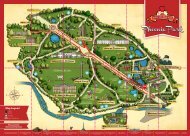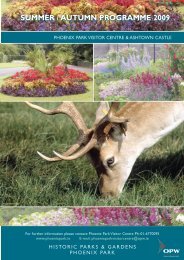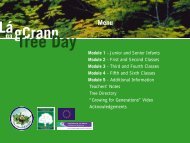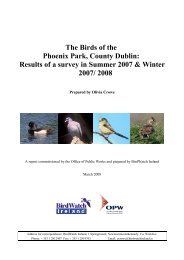Phoenix Park Conservation Management Plan
Phoenix Park Conservation Management Plan
Phoenix Park Conservation Management Plan
Create successful ePaper yourself
Turn your PDF publications into a flip-book with our unique Google optimized e-Paper software.
History and Description<br />
All the important lodges and accompanying demesnes, which were originally occupied by <strong>Park</strong> Rangers<br />
or Keepers, were purchased for Government use as private dwellings for the chief officers of state. These<br />
included the Viceregal Lodge for the Lord Lieutenant (now Áras an Uachtaráin), the Chief Secretary’s<br />
Residence (now the residence of the U.S. Ambassador to Ireland) and the Under-Secretary’s Residence<br />
(subsequently the Papal Nunciature and now The <strong>Phoenix</strong> <strong>Park</strong> Visitor Centre).<br />
The 19 th Century and the Decimus Burton Era<br />
The beginning of the 19 th century saw the <strong>Park</strong> in a much-neglected state with poor drainage, the roads in bad<br />
order and most of the trees very old and/or in a state of decay. However with the Commissioners of Woods<br />
and Forests taking over the management of the public areas of the <strong>Park</strong> and the employment of the renowned<br />
architect/landscape architect, Decimus Burton, all this was about to change. Burton produced a master plan<br />
for the <strong>Park</strong> which included the building of new gate lodges, the removal and levelling of old hedgerows<br />
and shooting butts, tree planting in strategic locations, drainage, the restoration of the boundary wall and<br />
creation and realignment of the <strong>Park</strong> roads, which included Chesterfield Avenue. This latter project involved<br />
the relocation of the <strong>Phoenix</strong> Column on the main avenue. Burton’s involvement for nearly two decades<br />
represents the greatest period of landscape change since the <strong>Park</strong>’s creation by the Duke of Ormond.<br />
Further improvements were undertaken following the transfer of management of The <strong>Phoenix</strong> <strong>Park</strong> to<br />
the Office of Public Works in 1860, the first of which included the completion of the outstanding works<br />
associated with the Wellington Testimonial which was commenced in 1818. Two further memorials of<br />
considerable artistic merit were unveiled – one in 1870 commemorating the Lord Lieutenancy of the Earl<br />
of Carlisle and the other an equestrian statue commemorating Field Marshal Viscount Gough which was<br />
unveiled in 1880 – both of which were sculpted by John Henry Foley.<br />
From the 1830s and particularly after the 1860s, sporting and recreational activities became prominent. The<br />
Royal Dublin Zoological Society opened Dublin Zoo in 1830. The Promenade Grounds opened in 1840<br />
(later to be known as the People’s Gardens) and were considerably improved in the 1860s with the addition<br />
of a Head Gardener’s House, rock gardens and horticultural facilities to allow for flower production for<br />
planting in the Gardens. Between the People’s Gardens and Dublin Zoo, a bandstand and tearooms were<br />
built in the final decade of the 19 th century.<br />
Although the military dominated in the <strong>Park</strong>’s institutions and <strong>Park</strong> use in the 18 th century, their influence<br />
was lessened somewhat in the 19 th century (though Mountjoy Barracks became the Irish headquarters of<br />
the Ordnance Survey in 1825). The presence of the police become more prominent, as illustrated by the<br />
construction in 1842 of the Royal Irish Constabulary depot near the North Circular Road entrance to the<br />
<strong>Park</strong> and two police barracks – one at Ashtown Gate and the other at <strong>Park</strong>gate Street Gate In 1848 the<br />
Commissioners of Woods and Forests further met their social obligations by providing for the educational<br />
needs of the <strong>Park</strong>’s children by building a school house and teacher’s residence to the designs of Decimus<br />
Burton.<br />
The 20 th Century<br />
The history and landscape management of The <strong>Phoenix</strong> <strong>Park</strong> in the 20 th century is characterised primarily<br />
by replanting of trees and shrubs that took place in the first decade, due to the great storm in 1903 which<br />
was responsible for the demise of nearly 3,000 trees. Another 10,000 trees were planted as part of the 1986<br />
management plan and considerable arboricultural works were carried out on the mature tree population in the<br />
latter quarter of the century.<br />
22<br />
THE PHOENIX PARK CONSERVATION MANAGEMENT PLAN
















